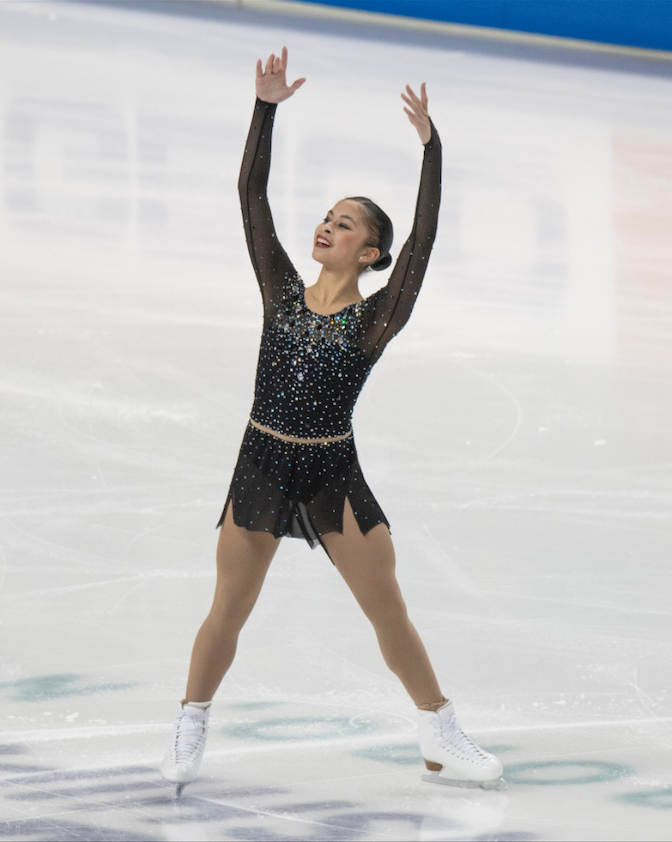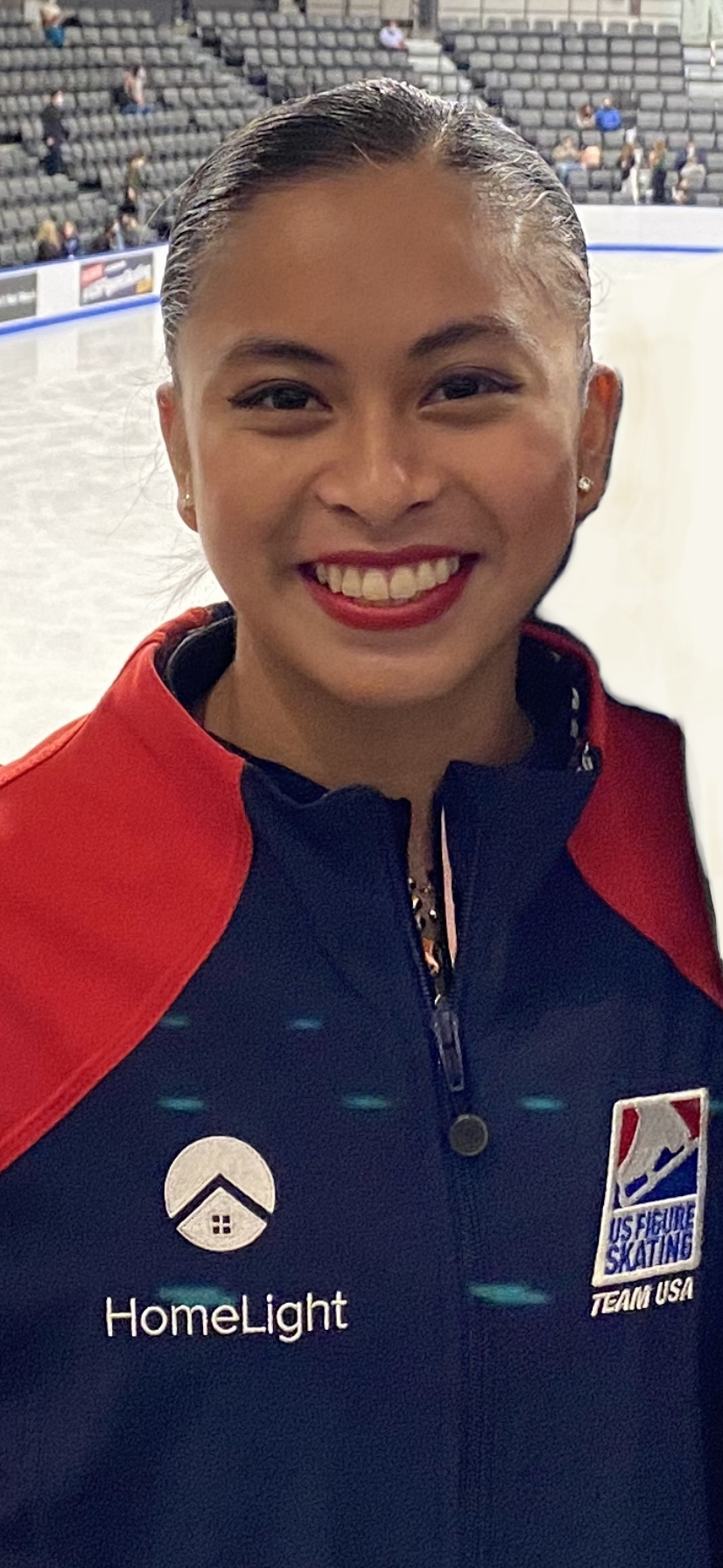Maxine Bautista is a 20 year-old competitive figure skater. She began skating at age five and is presently in her fifth year of competing at the Senior level. She has competed nationally and internationally as a member of Team USA’s International Selection Pool (ISP). In this article, Maxine acquaints us with figure skating insiders’ knowledge and discusses her own experiences competing in the sport.
Born and raised in Chicago, Illinois, Maxine began skating at five-and-a-half years old after her dad spotted a flyer for a local skating rink. “I remember my first class, I fell down so many times. My parents were like, ‘We’re not coming back.’ I’m glad I ended up sticking with it, though.”
At age six, Maxine competed at her first skating competition. At the time, she was taking dance lessons alongside figure skating, and eventually was made to choose between the two. She decided to skate full time, but her dance background smoothly translated into the artistry component of skating. “My favorite part of figure skating,” Maxine says, “is just doing choreography and skating around to music.”
Skating Elements: Jumps

Beyond the musically expressive nature of figure skating, skaters are required to perform elements in their programs that are awarded points based on execution and technique. In individuals’ skating, the first of such elements are jumps. Perhaps the most thrilling, and dangerous, aspect of the sport, skaters glide along a frictionless surface at high speeds and use the momentum to jump high into the air, where they perform single, double, triple, and even quadruple rotations, before landing solidly on a single 4 millimeters-thick blade.
Maxine explains her own experience with jumps. “When I’m first learning a new jump, I do mental ‘walkthroughs’, where I think about each component of the jump before doing it on the ice. Doing it off ice helps a lot. If I can do it off ice, it’s a little bit easier to do on ice, because you have the speed and momentum to help. I practice new jumps using a harness on ice first. After that, I need to not overthink [the jump], because the minute that happens I start second-guessing myself.”
Maxine’s favorite jump is the triple toe loop. “It’s funny because the double toe, which is a step down from triple toe, used to be my least favorite jump. I would not like to do it.”
In recent years, a growing number of ladies figure skaters, most notably in Russia, are attempting quadruple-rotation jumps in an effort to rack up more points in competition. On the topic of quad-fever– what some deem an overzealous pursuit of difficult jumps that may be detrimental to young skaters’ long-term health and longevity in the sport– Maxine states, “Honestly at this point, I think you do need quads to be competitive internationally, because there are so many ladies doing quads now. Especially if you land it, that jump is worth a lot of points.” Asked if she herself has attempted a quad, Maxine says, “I’ve tried them here-and-there on the harness.”
Skating Elements: Spins

The next major skating element after jumps is spins. Without the hindrance of friction, skaters can spin up to 300 revolutions per minute. It is hard not to imagine skaters getting dizzy after completing that many rotations at lightning speeds. But, as Maxine points out, dizziness is something skaters can outgrow with enough practice. She explains how spins are judged in competition. “There are four levels of spins, and each level is awarded a set of points. To get the highest level, Level 4, you need four different features in the spin. Examples of features include having a difficult variation, holding a position for eight rotations, and/or including a jump within a spin. You need to have at least four features to get a Level 4. Judges can downgrade the spin if you don’t hit enough rotations.”
At competitions there is a designated person, called a technical specialist, whose job is to count the number of rotations for each spin performed. Also counting rotations are the skaters themselves. Maxine explains, “You actually have to count the number of rotations you do while you’re spinning. If you’re just going by spotting, it kind of works, but it can be inconsistent, because what if you’re not spotting the same point?”
Competitive Highlights
Maxine recalls two standout moments in her skating career. “One was making it to Nationals in 2020, which was my first time qualifying on the Senior level. It was great to skate pretty well, too. I placed 11th, right out of the top 10, which is pretty good, considering all the people I was up against.” Her rivals that year included Mariah Bell, Alysa Liu, and Karen Chen, who were recently named to the US Figure Skating Olympic Team for the upcoming Beijing Olympics.

Maxine recounts another competitive highlight. “This past September I got an assignment to compete for Team USA. It was the US International Classic in Boston. It was so exciting because one of the top Russian skaters, Alexandra Trusova, was competing there too. I was definitely nervous because in the short program, I skated right after her.”
When asked about her short-term and long-term goals for skating, Maxine says, “My short term goal is always to make it to Nationals each year. Like everyone, I want to qualify and go to the Olympics. I definitely want to still be involved in skating even after I finish [competing]. My goal is to be a choreographer and maybe coach on the side, but I think choreography would be really fun.”
Longevity in Sport
These days in figure skating, there exists a clash of ideals: training difficult and dangerous jumps like quads and triple axels in order to be competitive internationally, or preserving one’s physical health by avoiding such risky jumps to have a long, sustained career. Asked her thoughts on these diverging ideologies, Maxine says, “In the US, definitely there is a greater push towards longevity. There are skaters who are still competing in their late 20s and early 30s. I feel like everyone is always trying to hang on a little bit longer. To have a long skating career, I would say that off-ice training is super important. Also, everyone needs to take rest days. If you go for too long you start to burn out, both physically and mentally.”
COVID and Skating
When COVID hit, skating rinks around the world shut their doors. Figure skaters like Maxine were suddenly left without ice to train on. “COVID affected everything. No rinks were open, and there were no competitions. During the whole time we were in lockdown in Illinois, I trained with my coach almost every day doing off-ice jumps and conditioning. I tried to keep up as much as possible. Once we started getting back into training, we got everything back pretty quickly. We were still doing a lot of our jumps off ice, so that helped.”
For Maxine, COVID bore consequences beyond that of closed rinks and canceled competitions. At one point during the pandemic, she questioned her desire to stay in competitive figure skating. “COVID happened the year after Senior Nationals. After that, I was on this real high, I was motivated to train and do well and make it to the next Nationals, and hopefully make it to internationals. When everything stopped, I was like, ‘What am I gonna do now?’ When rinks opened up again, it didn’t feel completely back to the way it was before. So I was like, ‘Do I really want to keep going?’ That season after COVID, I didn’t make it to Nationals. But then I got new programs, and I got that excited feeling again, and the motivation came back. I found myself again.”
Presently, Maxine is skating full-time. She is also coaching young figure skaters and finds fulfillment in helping them reach their goals. To her students, she offers the following piece of advice: “This sport is really tough and everyone gets so caught up in trying to win. But people need to enjoy skating more. Enjoy the process of learning new elements. Also, to have confidence in yourself and just go for it whether it be trying a new jump or competing for the first time.”

